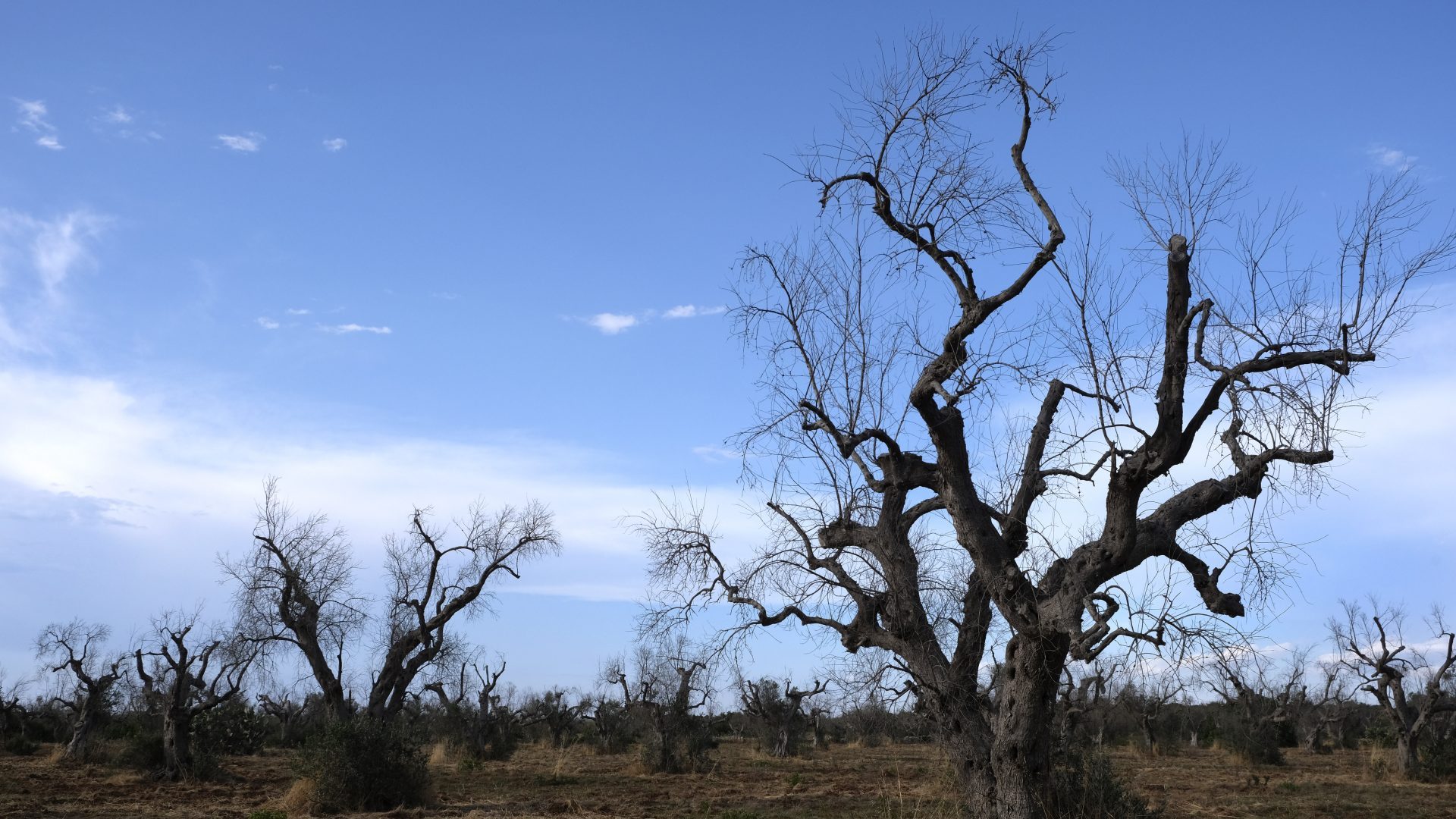“It’s like a cemetery now – all the olives in the Salento peninsula are dead, their branches like skeletons,” Flo Tanzarella lamented over the phone a week ago. The plague of Xylella has laid waste to the world’s prime olive-growing area of Puglia, in the heel of Italy’s boot. Now its trees, some hundreds of years old, look like a nightmare from a Tim Burton movie.
Flo runs ecological tours in Ostuni, a major centre for producing extra virgin olive oil. From there she tracks the passage of Xylella, a devastating bacteria spread by insects that infects and chokes the sap-conducting vessels in a tree. It is held responsible for the deaths of millions of olive trees worldwide, and counting. “Yes, it has reached us here at Ostuni – we have got the first signs – and it looks as if it’s travelling north,” she says.
Most worrying for Flo and her husband Gianfranco, an agronomist and olive farmer, is that the infection is spreading to new species. “There are signs here in Ostuni that it is getting into the macchia,” the natural scrub growth native to the Mediterranean, she sighs.
As the Tanzarellas wait anxiously, national and international agencies – including the EU, UN and Defra in the UK – are again trying to raise public awareness of the threat of a natural disaster. What is now known as Olive quick decline syndrome (OQDS), they say, could end up affecting at least 500 species, including lavender, rosemary, and some grape varieties. And given its alarming pattern of migration – it is thought to have originated in the Americas, arrived in Italy in 2008 on ornamental coffee plants sent from Costa Rica and has since spread to France, Spain, Portugal, Greece, Morocco and Tunisia – there are fears that the disease could be on the same pandemic scale as Dutch elm disease and ash dieback, which have caused destruction over the last century.
“It could affect many broad-leaf varieties, including British native trees,” says Dr Stefan Buczacki, eminent botanist and founder member of the BBC’s Gardeners’ Question Time. But there are no signs so far of a major outbreak in the UK, where public awareness campaigns have focused on the carrier, the spittlebug or froghopper, an insect that squirts a foam containing the bacterium on to the leaves of its unsuspecting plant victims.
The brutal facts of the outbreak in Puglia alone were spelled out in a report by Coldiretti, Italy’s national farmers’ association, at the end of April. In the decade from 2013, when OQDS was first noticed in Italian olive trees, Puglia has lost 40% of its olive crop, a total of around 21m trees. The “great olive massacre”, as Coldiretti calls it, has caused a drop in the national output of olio extra vergine to 208m kilos for the 2022-23 season from 329m the previous year.
To counteract its spread, the EU has issued export bans on olive plants for 12 countries. Britain is employing similar measures, and has joined with research programmes to study the bacterium Xylella fastidiosa and its subspecies, Xylella pauca and multiplex, as the well as the behaviour of the spittlebug, or sputacchina (cuckoo spit) in Italian.
The bacterium is carried by the spittlebug from tree to tree. It can take up to 14 months for the disease to show – but by then it is too late. The pathogen blocks the path of nutrients and water passing up the tree from the roots. The leaves turn brown, often showing a “leopard spot” mottled effect, and the branches wither and die.
“Fortunately, it seems to be advancing more slowly,” says Corrado Rodio, whose family has farmed 30 hectares of olives at Azienda Brancati outside Ostuni for centuries, producing around 5,000 litres of the world’s best extra vergine each year. Some of his trees are two millennia old, he tells me, and were producing olives and oil when Julius Caesar was a boy.
“We try all the known remedies – but so far there is no absolute cure,” he says. “We put nets around the trees, make breaks and dig trenches. We use some herbicides and pesticides and take out any grass that could host the bugs. We are also grafting resistant varieties on to the older trees.”
Of more than 500 varieties of olive, only two have proved impervious to Xylella, Uliva Favolosa and Uliva Lecina. Some believe that grafting – innesto – won’t work in the long run. And there are other concerns, too: a couple of years ago a local court ordered the lifting of measures to stop the spread of the infection, arguing that they were useless. Rumours soon spread that the case to lift the restrictions had been orchestrated by local crime bosses eager to keep profits flowing in the short term while risking the future.
Rodio believes that science will come up with a solution, but hopes it won’t be too late: “If we have to adopt Favolosa trees, the whole landscape changes. They are small trees grown intensively in industrial plots. The old olive groves disappearing means a change in a whole aspect of the Mediterranean landscape.”
On the hills beyond Ostuni, Rodi’s neighbour, Gianfranco Cola, runs the Azienda Agricola Columella, where he demonstrates new techniques in biodynamic agriculture. He is equally worried by the unpredictable pattern of Xylella’s advance. “It’s slower in some parts than others – it has taken almost all the crop in Salento, and a large part of Lecce. In the province of Taranto, it is moving in – showing the characteristic leopard spots on the leaves, and suggesting some trees are only partly infected,” he says.
He and Corrado are tracking work in specialised labs across Europe, and now adopting the fast-growing Uliva Favolosa. In Ostuni, they now believe that the disease is sure to travel north, under pressure from climate change. “The summers are getting much hotter now,” a farmer told me, “so the bug will seek more humid conditions, which it needs to feed and breed.”
An almost utopian solution is being pioneered by Luigi de Vecchi, an entrepreneur and philanthropist whose Fondazione Sylva promotes more caring for the local countryside. “Puglia once was forest, and the olives came relatively lately, in the last two centuries or less,” he says, suggesting that new woodlands should be planted to break up the monoculture of olive production. He is supported by the ecologist Daniele Rielli, author of a bestseller about the great olive massacre. It is titled The Invisible Fire – a human story of a natural disaster. But the growth of new trees and plants does not guarantee a brake on Xylella – other woodland varieties may become susceptible to it; clover and alfalfa – known as lucerne in the UK – already are.
Meanwhile, British botanists and farmers keep watch. Vigilance and awareness campaigns, including BRIGIT – with a video narrated by Dame Helen Mirren, whose own olive plants have been caught by Puglia’s outbreak – are thought to have been effective. It recommended close monitoring of the spittlebugs and froghoppers promiscuously spreading their larvae in foam globules on a host of plants. Yet if just one of these excretions carries Xylella, that might be the tipping point.
Prof Saskia Hogenhout of Norwich’s John Innes Centre, which conducts research into plant and microbial science, is watching for the changes in the bacterium itself, the different plants it appears in, and in its carrier insects. There are now at least 20 different subspecies of the froghopper and spittlebug tribe.
Meanwhile, any new plant or shrub of a known vulnerable species – like an olive tree or ornamental coffee shrub – being sold in Britain has to be inspected. Imports are banned. So far at least, the new restrictions and inspection requirements have been observed by the trade.
“But,” warns Prof Hogenhout, “the spread in Europe is becoming really challenging.” Climate change has brought very dry summers and unbearable heat in southern Spain and Italy, she says, and “the insects like humidity”. The UK is both cool and humid – ideal conditions for the spread of Xylella in its many forms.
Dr Steve White, who runs research at the UK Centre for Ecology & Hydrology, thinks that Xylella is sure to come to Britain. “We have to look at the different cultivars (plants)
that become hosts, as well as the vectors, the carriers,” he says. “I am not sure yet if it will get to the broad-leaf trees. But it will arrive on these shores. But how damaging – who knows?”
Buczacki, the veteran of Gardeners’ Question Time, also believes that how far the disease could go is an open question. But he too believes it will come to Britain, and the scale of the damage it could do is made clear on the Royal Horticultural Society’s website. As well as olive trees, Xylella is already hitting rosemary, lavender, oleander, plums, cherries, almonds and coffee. Vulnerable species include ash, maple, plane, oak, blueberries and grapevine.
The spittlebugs are out in force now this summer. Their foamy sputum gleams on lavender and rosemary. Just one or two could carry Xylella. And the wipeout of the olives of southern Puglia suggests that its arrival could bring us a story that might put even Dutch elm and ash dieback in the shade.



